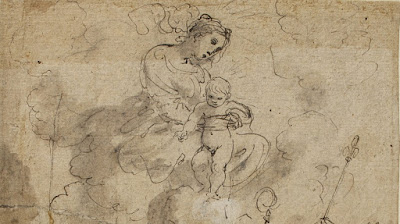 |
| Guercino (Giovanni Francesco Barbieri) Virgin and Child with Saints Joseph, Augustine, Louis, Francis, and a young Donor 1616 oil on canvas Musées Royaux des Beaux-Arts, Brussels |
 |
| Guercino (Giovanni Francesco Barbieri) Virgin and Child with Saints Joseph, Augustine, Louis, Francis, and a young Donor (detail) 1616 oil on canvas Musées Royaux des Beaux-Arts, Brussels |
 |
| Guercino (Giovanni Francesco Barbieri) Virgin and Child with Saints Joseph, Augustine, Louis, Francis, and a young Donor 1616 drawing (compositional study) Musée du Louvre |
 |
| Guercino (Giovanni Francesco Barbieri) Virgin and Child with Saints Joseph, Augustine, Louis, Francis, and a young Donor 1616 drawing (compositional study) Universitätsbibliothek Erlangen, Nürnberg |
"This 'key work' in Guercino's stylistic development was executed, according to [Carlo Cesare] Malvasia, in 1616, for the church of Sant'Agostino, Cento. In 1796 it was seized by the French and exhibited at the Louvre, whence it was sent in 1802 to Brussels, where it was restored by the Belgian flower painter, dealer and restorer Pieter-Joseph Thijs (1749-1807) and where it has remained ever since. [Orazio Cammillo] Righetti identified the donor portrait as representing Giuseppe Gaetano Righetti, presumably either the patron of the chapel or a member of his family."
 |
| Guercino (Giovanni Francesco Barbieri) Prometheus (bringing life to clay statue with a burning torch) ca. 1616 detached fresco Fondazione Cassa di Risparmio di Cento |
 |
| Guercino (Giovanni Francesco Barbieri) The Annunciation ca. 1616 drawing Royal Library, Windsor |
"Around 1616, Guercino painted his Prometheus, a fresco a secco on a chimneybreast in a room of the Casa Fabri, in Cento, the residence of another patron, Bartolomeo Fabri. (Within months of its completion, Fabri had put the room at the artist's disposal as the venue for his Accademia del Nudo [see previous post].) This, too, is now detached and belongs to the Fondazione Cassa di Risparmio, Cento. The upright format and the arrangement of the figures are reminiscent of some of the painted chimneybreasts in the Casa Pannini. At its outset, a drawing of The Annunciation [directly above] may have been intended for the Prometheus, as the angel holds a burning candle to the Virgin's breast, later substituted by a lily. At the time of the Casa Fabri commission, Guercino began painting in buon fresco. His experimentation with the technique coincides with his abandonment of the illustrative style of the Casa Provenzale and Casa Pannini decorations and his adoption of a monumental 'neo-Carraccesque' style of composition. Taking the place of small, full-length figures darting about within a stage-like setting, space is now occupied by a few large-sized figures brought close to the picture plane."
 |
| Guercino (Giovanni Francesco Barbieri) Theatrical Performance in the Open Air before 1621 drawing British Museum |
"The Fabri were also patrons of theatre and music. In Giuseppe Maria Pannini's memorandum of events in Cento in the first half of the 17th century (1655), he mentioned an operatic performance of Aminta Pastorale that had taken place, probably soon after 1620, in a theatre that the Fabri had been using especially for staging plays and concerts to entertain the people of Cento and to prevent 'young people from falling prey to idleness.' Guercino's early drawing [directly above] of an open-air theatrical performance in the British Museum, London, datable before 1621, may not represent that specific production, but it surely preserves the atmosphere of such an event."
 |
| Guercino (Giovanni Francesco Barbieri) Virgin teaching the Christ Child to Read (Mater Sapientiae) ca. 1616 oil on canvas Wallraf-Richartz Museum, Cologne |
 |
| Matteo Loves (attributed) after Guercino Virgin teaching the Christ Child to Read (Mater Sapientiae) ca. 1620 etching British Museum |
 |
| Guercino (Giovanni Francesco Barbieri) Virgin and Child with the infant St John the Baptist ca. 1616-17 oil on canvas Scottish National Gallery, Edinburgh |
 |
| Guercino (Giovanni Francesco Barbieri) Virgin and Child with the infant St John the Baptist ca. 1616-17 drawing (figure study, sleeping Child) Nasjonalgalleriet, Oslo |
 |
| John Hamilton Mortimer after Guercino Virgin and Child with the infant St John the Baptist 1766 etching British Museum |
 |
| Guercino (Giovanni Francesco Barbieri) Holy Family ca. 1616-17 oil on canvas (unfinished) Pinacoteca Capitolina, Rome |
"Traditionally attributed to the circle of Guido Reni, the picture was considered to be by Annibale Carracci by Roberto Longhi (his oral opinion recorded by [Luigi] Salerno), a suggestion based on some similarities to a print by Annibale of the subject (showing the figures whole length), dated 1590. [Denis] Mahon, however, recognized it as an unfinished early work by Guercino, in which the influence of Ludovico rather than Annibale Carracci prevails."
 |
| Guercino (Giovanni Francesco Barbieri) The Trinity ca. 1616-17 oil on canvas UniCredit, Bologna |
 |
| Guercino (Giovanni Francesco Barbieri) Landscape with a Country Fair ca. 1616-18 tempera on canvas Pinacoteca Vaticana, Rome |
"The painting was long hidden from view, having been on deposit as 'anonimo bambocciaro romano del XVII secolo' in an archbishop's apartment at the Vatican, where Massimo Pulini happened upon it unexpectedly some 20 years ago. Before that, it had hung in one of the rooms of the Archivio Fotografico of the Vatican Museums. On its rediscovery, it was given centre stage and placed in the context of contemporary landscapes and popular culture in the exhibition Guercino: Racconti di paese, organised by Pulini at the Pinacoteca Civica, Cento, in 2001. It is now on display in the 17th-century galleries of the Pinacoteca Vaticana."
– quoted texts from The Paintings of Guercino: a revised and expanded catalogue raisonné by Nicholas Turner (Rome: Ugo Bozzi Editore, 2017)